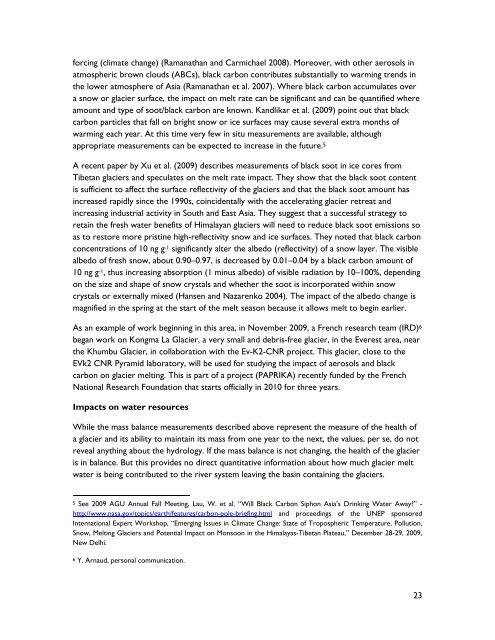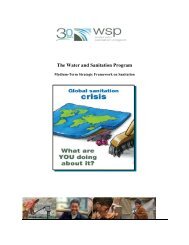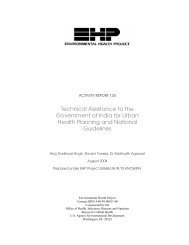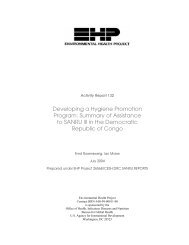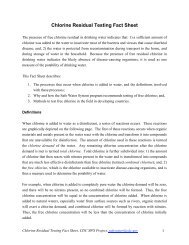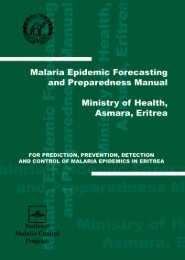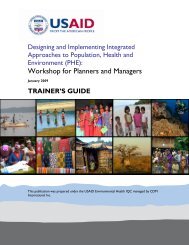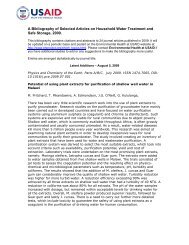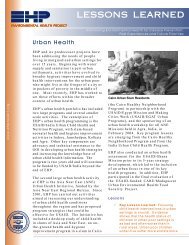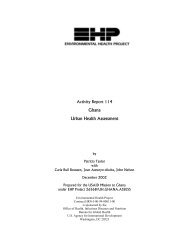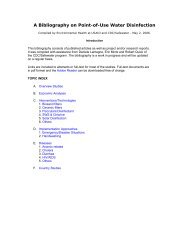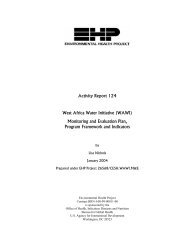Changing Glaciers and Hydrology in Asia - Environmental Health at ...
Changing Glaciers and Hydrology in Asia - Environmental Health at ...
Changing Glaciers and Hydrology in Asia - Environmental Health at ...
- No tags were found...
You also want an ePaper? Increase the reach of your titles
YUMPU automatically turns print PDFs into web optimized ePapers that Google loves.
forc<strong>in</strong>g (clim<strong>at</strong>e change) (Raman<strong>at</strong>han <strong>and</strong> Carmichael 2008). Moreover, with other aerosols <strong>in</strong><strong>at</strong>mospheric brown clouds (ABCs), black carbon contributes substantially to warm<strong>in</strong>g trends <strong>in</strong>the lower <strong>at</strong>mosphere of <strong>Asia</strong> (Raman<strong>at</strong>han et al. 2007). Where black carbon accumul<strong>at</strong>es overa snow or glacier surface, the impact on melt r<strong>at</strong>e can be significant <strong>and</strong> can be quantified whereamount <strong>and</strong> type of soot/black carbon are known. K<strong>and</strong>likar et al. (2009) po<strong>in</strong>t out th<strong>at</strong> blackcarbon particles th<strong>at</strong> fall on bright snow or ice surfaces may cause several extra months ofwarm<strong>in</strong>g each year. At this time very few <strong>in</strong> situ measurements are available, althoughappropri<strong>at</strong>e measurements can be expected to <strong>in</strong>crease <strong>in</strong> the future. 5A recent paper by Xu et al. (2009) describes measurements of black soot <strong>in</strong> ice cores fromTibetan glaciers <strong>and</strong> specul<strong>at</strong>es on the melt r<strong>at</strong>e impact. They show th<strong>at</strong> the black soot contentis sufficient to affect the surface reflectivity of the glaciers <strong>and</strong> th<strong>at</strong> the black soot amount has<strong>in</strong>creased rapidly s<strong>in</strong>ce the 1990s, co<strong>in</strong>cidentally with the acceler<strong>at</strong><strong>in</strong>g glacier retre<strong>at</strong> <strong>and</strong><strong>in</strong>creas<strong>in</strong>g <strong>in</strong>dustrial activity <strong>in</strong> South <strong>and</strong> East <strong>Asia</strong>. They suggest th<strong>at</strong> a successful str<strong>at</strong>egy toreta<strong>in</strong> the fresh w<strong>at</strong>er benefits of Himalayan glaciers will need to reduce black soot emissions soas to restore more prist<strong>in</strong>e high-reflectivity snow <strong>and</strong> ice surfaces. They noted th<strong>at</strong> black carbonconcentr<strong>at</strong>ions of 10 ng g -1 significantly alter the albedo (reflectivity) of a snow layer. The visiblealbedo of fresh snow, about 0.90–0.97, is decreased by 0.01–0.04 by a black carbon amount of10 ng g -1 , thus <strong>in</strong>creas<strong>in</strong>g absorption (1 m<strong>in</strong>us albedo) of visible radi<strong>at</strong>ion by 10–100%, depend<strong>in</strong>gon the size <strong>and</strong> shape of snow crystals <strong>and</strong> whether the soot is <strong>in</strong>corpor<strong>at</strong>ed with<strong>in</strong> snowcrystals or externally mixed (Hansen <strong>and</strong> Nazarenko 2004). The impact of the albedo change ismagnified <strong>in</strong> the spr<strong>in</strong>g <strong>at</strong> the start of the melt season because it allows melt to beg<strong>in</strong> earlier.As an example of work beg<strong>in</strong>n<strong>in</strong>g <strong>in</strong> this area, <strong>in</strong> November 2009, a French research team (IRD) 6began work on Kongma La Glacier, a very small <strong>and</strong> debris-free glacier, <strong>in</strong> the Everest area, nearthe Khumbu Glacier, <strong>in</strong> collabor<strong>at</strong>ion with the Ev-K2-CNR project. This glacier, close to theEVk2 CNR Pyramid labor<strong>at</strong>ory, will be used for study<strong>in</strong>g the impact of aerosols <strong>and</strong> blackcarbon on glacier melt<strong>in</strong>g. This is part of a project (PAPRIKA) recently funded by the FrenchN<strong>at</strong>ional Research Found<strong>at</strong>ion th<strong>at</strong> starts officially <strong>in</strong> 2010 for three years.Impacts on w<strong>at</strong>er resourcesWhile the mass balance measurements described above represent the measure of the health ofa glacier <strong>and</strong> its ability to ma<strong>in</strong>ta<strong>in</strong> its mass from one year to the next, the values, per se, do notreveal anyth<strong>in</strong>g about the hydrology. If the mass balance is not chang<strong>in</strong>g, the health of the glacieris <strong>in</strong> balance. But this provides no direct quantit<strong>at</strong>ive <strong>in</strong>form<strong>at</strong>ion about how much glacier meltw<strong>at</strong>er is be<strong>in</strong>g contributed to the river system leav<strong>in</strong>g the bas<strong>in</strong> conta<strong>in</strong><strong>in</strong>g the glaciers.5 See 2009 AGU Annual Fall Meet<strong>in</strong>g, Lau, W. et al. “Will Black Carbon Siphon <strong>Asia</strong>’s Dr<strong>in</strong>k<strong>in</strong>g W<strong>at</strong>er Away?” -http://www.nasa.gov/topics/earth/fe<strong>at</strong>ures/carbon-pole-brief<strong>in</strong>g.html <strong>and</strong> proceed<strong>in</strong>gs of the UNEP sponsoredIntern<strong>at</strong>ional Expert Workshop, “Emerg<strong>in</strong>g Issues <strong>in</strong> Clim<strong>at</strong>e Change: St<strong>at</strong>e of Tropospheric Temper<strong>at</strong>ure, Pollution,Snow, Melt<strong>in</strong>g <strong>Glaciers</strong> <strong>and</strong> Potential Impact on Monsoon <strong>in</strong> the Himalayas-Tibetan Pl<strong>at</strong>eau,” December 28-29, 2009,New Delhi.6 Y. Arnaud, personal communic<strong>at</strong>ion.23


